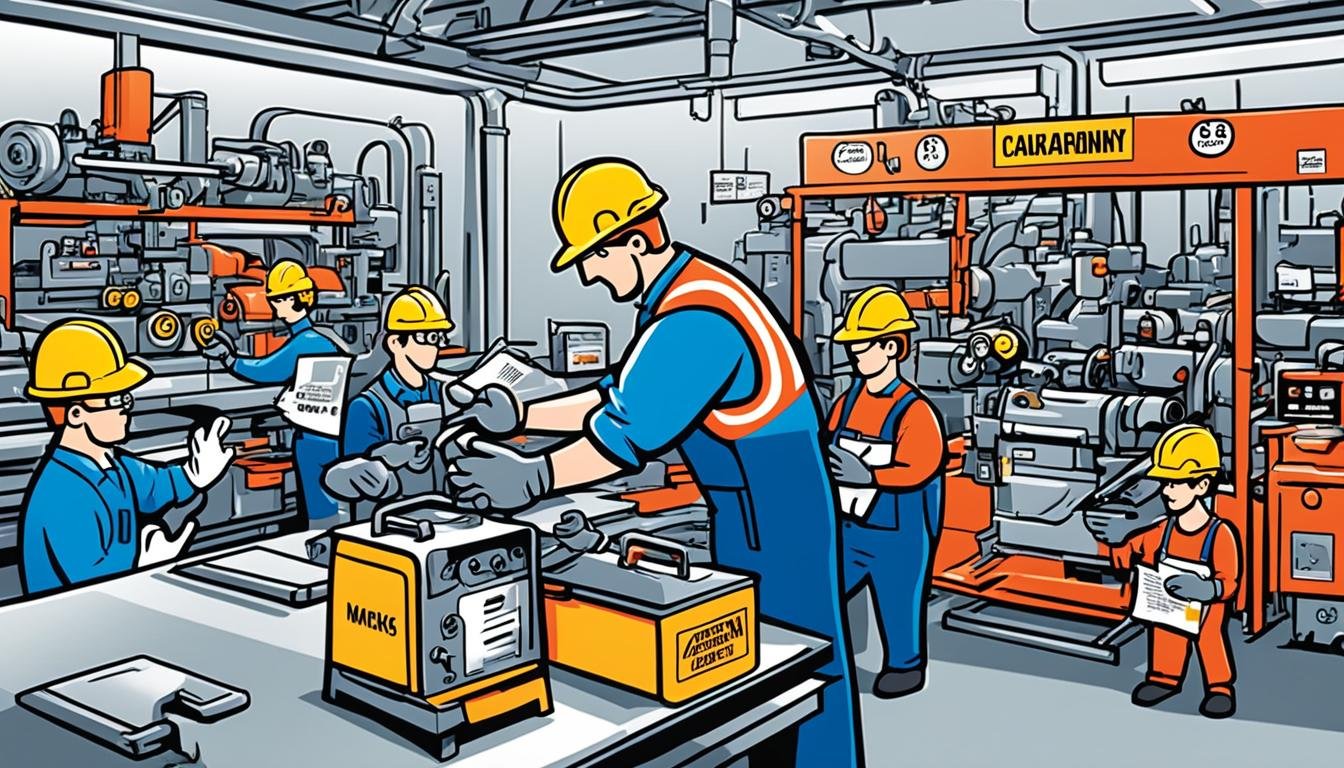OSHA Standards: Guide to Workplace Safety
Did you know that every day, over 14 workers in the United States suffer a fatal injury? That’s an alarming statistic that highlights the importance of workplace safety regulations and the need for businesses to comply with Occupational Safety and Health Administration (OSHA) standards. As a responsible employer, it is crucial to understand the OSHA compliance requirements and ensure that your workplace meets the necessary safety standards.
Key Takeaways:
- OSHA is responsible for enforcing workplace safety standards in the United States.
- Compliance with OSHA standards is crucial to ensure employee safety and prevent accidents.
- Different industries have specific OSHA standards that employers must adhere to.
- Implementing safety and health programs in the workplace offers numerous benefits, including injury prevention and cost reduction.
- Following recommended practices for safety and health programs can help businesses create safer work environments.
Understanding OSHA Standards
OSHA standards play a crucial role in ensuring workplace safety. These standards cover various industries, including general industry, construction, maritime, and agriculture. Employers must adhere to specific regulations relevant to their industry to maintain a safe work environment for their employees.
Compliance with OSHA standards requires the implementation of safety management protocols and adherence to workplace safety standards. It is essential for employers to stay updated with any changes in OSHA regulations through regular reviews to ensure ongoing compliance.
By understanding OSHA standards and their implications, employers can proactively address safety concerns, minimize workplace accidents, and protect the well-being of their workers.
Review the table below for an overview of OSHA standards by industry:
| Industry | Key OSHA Standards |
|---|---|
| General Industry | Personal protective equipment (PPE), safety training, workspace cleanliness |
| Construction | Fall protection, electrical safety, equipment maintenance |
| Maritime | Atmospheric testing, shipyard rescue team, oxygen content in confined spaces |
| Agriculture | Tractor safety, storage of hazardous materials, field worker protections |
By aligning their operations with these OSHA standards, employers demonstrate their commitment to the safety and well-being of their workforce.
General Industry Standards
OSHA’s general industry standards apply to businesses that are not specifically covered by other industries. Compliance with these standards is crucial for maintaining a safe and healthy workplace for employees. Let’s take a closer look at some of the OSHA compliance requirements, safety & health topics, and training requirements relevant to the general industry.
OSHA Compliance Requirements
Complying with OSHA standards is essential for ensuring workplace safety and avoiding penalties. Employers in the general industry must meet various compliance requirements set by OSHA, including:
- Providing Personal Protective Equipment (PPE) to employees
- Conducting regular safety inspections
- Maintaining cleanliness and orderliness in work areas
- Ensuring the safety of walking-working surfaces
These requirements are designed to protect employees from hazards and prevent workplace accidents and injuries.
Safety & Health Topics
OSHA covers a range of safety and health topics that employers in the general industry need to be aware of. These topics include:
- Hazard communication
- Electrical safety
- Ergonomics
- Machine guarding
- Lockout/tagout procedures
Understanding and addressing these topics play a vital role in maintaining a safe working environment.
Training Requirements
Proper training is crucial for employee safety and compliance with OSHA standards. Employers in the general industry must provide training on various topics, including:
- Emergency response procedures
- Fire safety
- Hazardous materials handling
- First aid and CPR
By ensuring that employees receive comprehensive training, employers can reduce the risk of accidents and create a culture of safety in the workplace.
Construction Standards
The construction industry has specific OSHA standards that employers must follow to ensure the safety of their workers. These standards outline the responsibilities of employers in the construction industry, including the provision of adequate training, first aid services, and personal protective equipment (PPE) for employees. Employers are also required to maintain cleanliness in work areas and ensure proper illumination to prevent accidents and hazards.
One crucial aspect of construction standards is fall protection. As construction workers often work at heights, it is essential for employers to provide fall protection systems and equipment to prevent falls and protect the well-being of their employees. Fall protection measures can include safety harnesses, guardrails, and safety nets, among others.
In addition to fall protection, employers in the construction industry must ensure the safe operation of electrical equipment to prevent electrical hazards. This involves regular inspections, maintenance, and adherence to electrical safety protocols.
OSHA provides checklists and resources to help employers comply with these construction standards and fulfill their responsibilities in promoting a safe working environment in the construction industry.
Maritime Standards
Maritime employers have unique OSHA standards to follow. These standards ensure the safety and well-being of workers in the maritime industry. Compliance with these standards is essential to prevent accidents and maintain a safe working environment.
One of the key requirements for maritime employers is conducting atmospheric testing. This involves regularly monitoring the air quality in confined spaces to ensure that it is safe for workers. Atmospheric testing helps identify potential hazards such as toxic gases or inadequate oxygen content. It is crucial to prioritize the health and safety of employees by taking necessary precautions based on the findings of atmospheric testing.
Additionally, maritime employers must inspect spaces for oxygen content. This is crucial to prevent asphyxiation or other oxygen-related hazards. Proper labeling of spaces that are not safe for workers is necessary to ensure that employees are aware of potential risks associated with those areas.
In the event of an emergency or accident, maritime employers are required to establish a shipyard rescue team. This team consists of trained personnel who can respond quickly and effectively to rescue workers in distress or provide necessary assistance during emergencies.
Employers must provide comprehensive training on confined space entry to maritime workers. This training equips employees with the knowledge and skills to work safely in enclosed spaces and mitigate potential risks. It is also essential to maintain a safe working environment with adequate oxygen content, ensuring the well-being of employees throughout their workday.
OSHA provides checklists to help maritime employers comply with the specific standards for their industry. These checklists serve as valuable resources to ensure that all necessary safety measures are in place and that employees are protected from potential hazards.
By adhering to maritime standards and prioritizing the safety of workers, maritime employers can create a secure and productive work environment while reducing the risk of accidents and injuries.
Key Points:
- Maritime employers must conduct atmospheric testing and inspect spaces for oxygen content to ensure the safety of workers.
- Proper labeling of unsafe spaces and establishment of a shipyard rescue team are vital to respond to emergencies effectively.
- Comprehensive training on confined space entry and a safe working environment with adequate oxygen content are essential for employee well-being.
- OSHA provides helpful checklists to assist maritime employers in meeting industry-specific standards.
| Maritime Standards | Requirements |
|---|---|
| Atmospheric Testing | Regularly monitor air quality in confined spaces to identify potential hazards. |
| Oxygen Content Inspection | Ensure proper oxygen content in work spaces to prevent asphyxiation and oxygen-related hazards. |
| Labeling Unsafe Spaces | Properly label spaces that are not safe for workers to raise awareness about potential risks. |
| Shipyard Rescue Team | Establish a trained team to respond to emergencies and rescue workers in distress. |
| Confined Space Training | Provide comprehensive training on confined space entry and safety protocols. |
Agriculture Standards
When it comes to the agriculture industry, ensuring the safety of workers is of utmost importance. OSHA has specific standards in place to protect field workers and prevent accidents and injuries. Compliance with these standards is essential for maintaining a safe working environment in agricultural settings.
One key aspect of agriculture standards is tractor safety. Tractors are commonly used in various farming operations, and it is crucial to prioritize the safety of those operating these powerful machines. OSHA requires employers to provide working seatbelts on tractors, which can greatly reduce the risk of injuries in case of rollovers or accidents. By ensuring that seatbelts are in good working condition and employees are properly trained on their use, employers can enhance tractor safety and protect their workers.
| OSHA Agriculture Standards | Key Requirements |
|---|---|
| Tractor Safety | – Provide working seatbelts on tractors – Properly train employees on tractor operation – Conduct regular maintenance and inspections of tractors |
| Hazardous Materials | – Store hazardous materials properly – Clearly label hazardous storage areas – Train employees on handling hazardous materials |
| Agricultural Equipment Operation | – Ensure employees are trained on the safe operation of equipment – Regularly inspect equipment for defects or issues – Provide appropriate personal protective equipment (PPE) |
| Field Worker Safety | – Provide clean drinking water to field workers – Implement heat stress prevention measures – Train workers on potential hazards in the field |
Proper storage of hazardous materials is another critical requirement outlined in agriculture standards. Agricultural operations often involve the use of pesticides, chemicals, and other substances that can pose risks to workers’ health if mishandled. OSHA mandates that employers store hazardous materials in a safe and secure manner, ensuring proper labeling and training employees on handling procedures.
In addition to tractor safety and hazardous materials, OSHA standards also focus on the safe operation of agricultural equipment. Employers must provide comprehensive training to employees on the proper use of equipment, conduct regular inspections to identify any defects or issues, and ensure the availability of appropriate personal protective equipment (PPE) to prevent injuries.
Field worker safety is another crucial aspect covered by agriculture standards. OSHA requires employers to provide clean drinking water to field workers, especially during hot weather conditions. Additionally, implementing measures to prevent heat stress and training workers on potential hazards they may encounter in the field are important considerations for ensuring the well-being of field workers.
Complying with OSHA’s agricultural standards is essential for the safety and well-being of farm workers. By adhering to these standards, employers not only protect their employees but also demonstrate their commitment to fostering a safe workplace environment.
OSHA Functions
OSHA plays a dual role as both a safety enforcer and a safety consultant. Its functions encompass workplace inspections, compliance monitoring, and providing guidance to businesses in their safety efforts.
As a safety enforcer, OSHA conducts regular inspections to ensure that employers comply with safety standards and regulations. These inspections are crucial for identifying any hazards or violations that may jeopardize employee safety. In cases of non-compliance, OSHA has the authority to impose penalties and take necessary enforcement actions to rectify the situation and protect workers.
On the other hand, OSHA also acts as a safety consultant by offering free consultations to businesses. During these consultations, OSHA professionals help employers identify potential hazards, assess their current safety programs, and develop effective strategies to mitigate risks. This guidance helps businesses in implementing comprehensive safety programs that align with OSHA requirements, industry best practices, and the specific needs of their workforce.
OSHA’s ultimate goal is to prevent workplace injuries, illnesses, and fatalities through proactive measures. By functioning as both a safety enforcer and a safety consultant, OSHA strives to create safer work environments, promote compliance with safety standards, and foster a culture of safety in workplaces across various industries.
Benefits of Safety and Health Programs
Implementing safety and health programs in the workplace offers several benefits. These programs play a crucial role in preventing workplace injuries and illnesses, ensuring compliance with laws and regulations, reducing costs, engaging workers, and enhancing social responsibility goals. Prioritizing workplace safety and health not only creates a safer work environment but also improves overall operations and protects the well-being of employees.
One of the key advantages of safety and health programs is their focus on workplace injury prevention. By implementing comprehensive safety protocols, businesses can minimize the risk of accidents and injuries, creating a safer and healthier work environment for their employees. This not only protects the individuals but also reduces disruptions to productivity and ensures the continuity of operations.
Moreover, safety and health programs help organizations remain compliant with laws and regulations. By adhering to OSHA standards and other relevant regulations, businesses can avoid penalties and legal complications. Compliance demonstrates a commitment to employee safety, building trust with both workers and regulatory bodies.
Cost reduction is another significant benefit of safety and health programs. By implementing preventive measures and maintaining a safe work environment, businesses can reduce costs associated with workplace injuries, illnesses, and their consequences. This includes medical expenses, compensation claims, legal fees, and potential productivity losses resulting from accidents.
Engaging workers in safety and health programs is essential for creating a positive work culture. When employees are actively involved in safety initiatives, they develop a sense of ownership and responsibility for their own well-being and the well-being of their colleagues. This collective commitment to safety fosters teamwork, communication, and a shared goal of creating a secure work environment.
Implementing safety and health programs also showcases an organization’s commitment to social responsibility. Businesses that prioritize employee safety and well-being not only fulfill their ethical obligations but also enhance their reputation as an employer of choice. This can attract and retain top talent, as employees value organizations that prioritize their health and safety.
Benefits of Safety and Health Programs:
- Prevent workplace injuries and illnesses
- Ensure compliance with laws and regulations
- Reduce costs associated with accidents and injuries
- Engage workers and foster a positive work culture
- Enhance social responsibility goals
In summary, safety and health programs offer numerous benefits to businesses. By implementing these programs, organizations can prevent workplace injuries, comply with laws and regulations, reduce costs, engage workers, demonstrate social responsibility, and improve overall operations. Prioritizing safety and health is not only a legal and ethical obligation but also a strategic decision that contributes to the long-term success and well-being of the organization.
Recommended Practices for Safety and Health Programs
Implementing effective safety programs is essential for maintaining a safe workplace environment. To achieve this, businesses can utilize the recommended practices for safety and health programs. These practices emphasize a proactive approach to workplace safety, focusing on identifying and addressing hazards before they cause harm. By following these practices, businesses can prevent workplace injuries, illnesses, and fatalities.
The recommended practices consist of seven core elements that form the foundation of a successful safety and health program. These elements contribute to the comprehensive management of workplace hazards and ensure the well-being of employees:
- Management leadership: Establish a strong commitment to workplace safety from all levels of management.
- Worker participation: Involve employees in the development and implementation of safety programs.
- Hazard identification and assessment: Regularly assess workplace hazards to identify potential risks.
- Hazard prevention and control: Implement measures to prevent and control workplace hazards.
- Education and training: Provide comprehensive safety training to employees.
- Program evaluation and improvement: Continuously evaluate the effectiveness of safety programs and make necessary improvements.
- Communication and coordination: Establish clear communication channels and coordinate efforts to ensure a cohesive safety program.
By incorporating these core elements, businesses can enhance their workplace safety initiatives and mitigate potential hazards effectively.
Proactive Approach to Workplace Safety
A proactive approach is a fundamental aspect of the recommended practices for safety and health programs. Instead of reacting to accidents or injuries, businesses should focus on implementing preventative measures to identify and address hazards before they result in harm. This proactive approach involves:
- Risk assessment: Conducting comprehensive assessments of the workplace to identify potential hazards.
- Hazard control: Implementing control measures to eliminate or minimize workplace hazards.
- Training and education: Providing employees with the necessary knowledge and skills to recognize and prevent workplace hazards.
- Continuous improvement: Regularly evaluating safety programs and making improvements based on feedback and incident analysis.
By adopting a proactive approach, businesses can create a safer work environment and reduce the likelihood of accidents and injuries.
| Core Elements | Description |
|---|---|
| Management leadership | Establish a commitment to workplace safety from management. |
| Worker participation | Involve employees in safety program development and implementation. |
| Hazard identification and assessment | Regularly assess workplace hazards to identify potential risks. |
| Hazard prevention and control | Implement measures to prevent and control workplace hazards. |
| Education and training | Provide comprehensive safety training to employees. |
| Program evaluation and improvement | Continuously evaluate safety programs for effectiveness and make necessary improvements. |
| Communication and coordination | Establish clear communication channels and coordinate safety efforts. |
Conclusion
Workplace safety is paramount for every business. Compliance with Occupational Safety and Health Administration (OSHA) standards and implementing effective safety programs are essential for protecting employee well-being and preventing accidents and injuries. By understanding and adhering to OSHA standards, employers can create safer work environments, improve compliance with regulations, and enhance overall productivity and success.
Prioritizing workplace safety should be a top concern for all businesses. By taking proactive measures such as conducting regular safety training, implementing safety management protocols, and staying updated with OSHA regulations, employers can ensure the well-being of their employees and create a culture of safety.
Not only does workplace safety reduce the risk of injuries and accidents, but it also leads to other benefits. It helps companies comply with OSHA’s rigorous standards and regulations, avoiding penalties and legal issues. Additionally, safety and health programs can help reduce costs associated with workplace injuries and illnesses, improve employee engagement, and contribute to the overall success of the business.
FAQ
What is OSHA?
OSHA stands for the Occupational Safety and Health Administration. It is responsible for ensuring that employees work in safe and healthful environments. OSHA sets and enforces workplace safety standards, provides training and education, and requires employers to comply with OSHA regulations.
What do OSHA standards cover?
OSHA standards cover a wide range of topics to ensure workplace safety. These standards include general industry, construction, maritime, and agriculture. Employers must comply with specific regulations for each industry.
What are the compliance requirements for workplace safety?
Compliance with OSHA standards involves implementing safety management protocols, following workplace safety standards, and regularly reviewing OSHA regulations to stay updated with any changes.
What are the general industry standards?
OSHA’s general industry standards apply to businesses that are not specifically covered by other industries. Employers in the general industry must comply with OSHA regulations, such as providing personal protective equipment (PPE) to employees and conducting safety training.
What are the construction standards?
The construction industry has specific OSHA standards that employers must follow. These standards include ensuring that employees are adequately trained, providing first aid services, and requiring the use of personal protective equipment (PPE).
What are the maritime standards?
Maritime employers have unique OSHA standards to follow. These standards include conducting atmospheric testing, inspecting spaces for oxygen content, and establishing a shipyard rescue team.
What are the agriculture standards?
OSHA has specific standards for the agriculture industry to ensure worker safety. These standards include providing working seatbelts on tractors, proper storage of hazardous materials, and training employees in the safe operation of agricultural equipment.
What functions does OSHA serve?
OSHA operates as both a safety enforcer and a safety consultant. As a safety enforcer, OSHA ensures compliance with safety standards through workplace inspections and imposes penalties for non-compliance. As a safety consultant, OSHA provides free consultations to businesses, helping them identify hazards and develop effective safety programs.
What are the benefits of safety and health programs?
Implementing safety and health programs in the workplace offers several benefits. These programs help prevent workplace injuries and illnesses, improve compliance with laws and regulations, reduce costs, engage workers, enhance social responsibility goals, and increase productivity.
What are the recommended practices for safety and health programs?
Recommended Practices for Safety and Health Programs provide a step-by-step approach to implementing effective safety programs. These practices emphasize a proactive approach and include seven core elements that form the foundation of a successful safety and health program.
Why is workplace safety important?
Workplace safety is crucial for protecting employee well-being and preventing accidents and injuries. By understanding and following OSHA standards, employers can create safer work environments, improve compliance with regulations, and enhance overall productivity and success.








